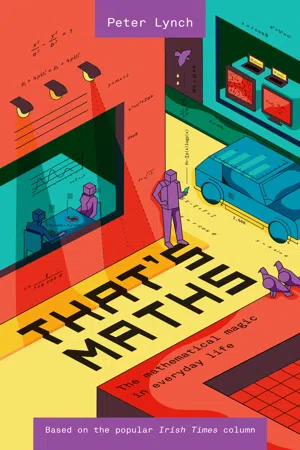
- 344 pages
- English
- ePUB (mobile friendly)
- Available on iOS & Android
eBook - ePub
About this book
From atom bombs to rebounding slinkies, open your eyes to the mathematical magic in the everyday. Mathematics isn't just for academics and scientists, a fact meteorologist and blogger Peter Lynch has spent the past several years proving through his Irish Times newspaper column and blog, That's Maths.Here, he shows how maths is all around us, with chapters on the beautiful equations behind designing a good concert venue, predicting the stock market and modelling the atom bomb, as well as playful meditations on everything from coin-stacking to cartography. If you left school thinking maths was boring, think again!
Frequently asked questions
Yes, you can cancel anytime from the Subscription tab in your account settings on the Perlego website. Your subscription will stay active until the end of your current billing period. Learn how to cancel your subscription.
No, books cannot be downloaded as external files, such as PDFs, for use outside of Perlego. However, you can download books within the Perlego app for offline reading on mobile or tablet. Learn more here.
Perlego offers two plans: Essential and Complete
- Essential is ideal for learners and professionals who enjoy exploring a wide range of subjects. Access the Essential Library with 800,000+ trusted titles and best-sellers across business, personal growth, and the humanities. Includes unlimited reading time and Standard Read Aloud voice.
- Complete: Perfect for advanced learners and researchers needing full, unrestricted access. Unlock 1.4M+ books across hundreds of subjects, including academic and specialized titles. The Complete Plan also includes advanced features like Premium Read Aloud and Research Assistant.
We are an online textbook subscription service, where you can get access to an entire online library for less than the price of a single book per month. With over 1 million books across 1000+ topics, we’ve got you covered! Learn more here.
Look out for the read-aloud symbol on your next book to see if you can listen to it. The read-aloud tool reads text aloud for you, highlighting the text as it is being read. You can pause it, speed it up and slow it down. Learn more here.
Yes! You can use the Perlego app on both iOS or Android devices to read anytime, anywhere — even offline. Perfect for commutes or when you’re on the go.
Please note we cannot support devices running on iOS 13 and Android 7 or earlier. Learn more about using the app.
Please note we cannot support devices running on iOS 13 and Android 7 or earlier. Learn more about using the app.
Yes, you can access That's Maths by Peter Lynch in PDF and/or ePUB format, as well as other popular books in Mathematics & Differential Equations. We have over one million books available in our catalogue for you to explore.
Information
THE FARADAY OF STATISTICS
In October 2012 a plaque was unveiled at St Patrick’s National School, Blackrock, to commemorate William Sealy Gosset, who had lived nearby for 22 years during the early twentieth century. Sir Ronald Fisher, a giant among statisticians, called Gosset ‘the Faraday of statistics’, recognising his ability to grasp general principles and apply them to problems of practical significance. Gosset’s name may not be familiar, but his work is known to anyone who has taken an introductory course in statistics. Using the pseudonym Student, he published a paper in 1908 that has been of importance ever since.
Gosset was born in Canterbury, Kent, in 1876 into an old Huguenot family. He studied chemistry and mathematics at Oxford, graduating in 1899 with first class honours in both subjects. He then joined Arthur Guinness & Son in Dublin as a chemist, and worked at the brewery in St James’s Gate for 36 years, before becoming head brewer at a new Guinness brewery at Park Royal in London.
Guinness was interested in agricultural experimentation and hired scientists who could apply their expertise to the business. Gosset was one of these, and he used statistics to solve a range of problems connected with brewing, ranging from barley production to yeast fermentation, that affected the quality of the product. One problem involved the selection of varieties of barley that produced maximum yields in given soil types and allowing for the vagaries of climate.
To extend his knowledge, Gosset spent a year at the biometric laboratory of the leading statistician Karl Pearson at University College London. Reliable statistics require an adequate sample size. Gosset soon realised that Pearson’s large-sample theory required refinement if it was to be useful for the small-sample problems arising in brewing. His fame today rests on a statistical test called Student’s t-test.
But why Student? Gosset’s main paper, ‘The Probable Error of a Mean’, was published in 1908. But to protect trade secrets, Guinness would not allow employees to publish the results of their research. They wished to keep secret from competitors the advantages gained from employing statisticians. Gosset persuaded his bosses that there was nothing in his work that would benefit competitors, and they allowed him to publish, but under an assumed name. Hence, anyone studying statistics encounters the name Student rather than that of the true author of the method.
Gosset’s work has proved fundamental to statistical inference as practised today. His great discovery was to derive the correct distribution for the sample mean. Student’s t-test arises when we estimate the average value of a randomly varying quantity from a small sample. It plays a crucial role in statistical analysis: for example, it is used to evaluate the effect of medical treatment, when we compare patients taking a new drug with a control group taking a placebo. It was also central to the development of quality control, which is vital in modern industry.
THE CHAOS GAME
The term ‘Chaos Game’ was coined by Michael Barnsley, who developed this ingenious technique for generating mathematical objects called fractals. The Chaos Game is a simple algorithm that identifies one point in the plane at each stage. The sets of points that ultimately emerge from the procedure are remarkable for their intricate structure. The relationship between the algorithm and fractal sets is not at all obvious because there is no evident connection between them. This element of surprise is one of the delights of mathematics.
THE SIERPINSKI GASKET
Let’s specify the algorithm in a simple case. We need a dice (I should say die but that feels odd) with three numbers. We can use a standard dice and identify 6 with 1, 5 with 2 and 4 with 3; that is, for face n we call it min (n, 7 – n).
1. Fix three points in the plane, C1, C2 and C3. For definiteness, we take the points C1 = (0, 0), C2 = (1, 0) and C3 = (0.5, √3/2), the corners of an equilateral triangle.
2. Pick any point P0 and draw a dot. This is our starting point. At each stage, we denote the current point by Pk and call it the game point.
3. Roll the dice. If n comes up, draw a point halfway between Pk and Cn. For example, if we roll a 2, we pick the point halfway between the current point Pk and C2. This is the new game point.
4. Repeat this procedure many times, drawing a new point at each step.
We seek the attractor of the mapping, so we eliminate the initial points, let’s say the first 100 points. It is difficult to anticipate the outcome of this algorithm, but the figures below reveal all. We plot the results at several stages of the procedure, with k = 500, 1000 and 2000. We can see a structure forming. It is the famed Sierpinski Gasket.

The Chaos Game for three points at the vertices of an equilateral triangle, showing the output after 500, 1000 and 2000 steps.
BARNSLEY FERNS
Michael Barnsley generalised the Chaos Game to produce a wide range of fractal sets. He based it on a mathematical structure called an Iterated Function System (IFS). Starting with a point (xk, yk) in the plane, the next point is fr(xk, yk), where fr is a member of the IFS, chosen with a specified probability pr. In the simplest cases, the maps fr are linear or affine transformations.
Probably the most famous example is the so-called Barnsley Fern. The algorithm or procedure is very similar to that described for the Sierpinski Gasket, but now four different linear maps are used instead of one, and the choices between them are made on the basis of random numbers, with prescribed probability for each map. The algorithm can be coded in a few lines of computer code. We show the results at several stages below.

Barnsley Fern generated by the Chaos Game. From left to right: 1000, 10,000 and 100,000 points.
The final result is a set of considerably beauty. The structure of the set built up by the Chaos Game bears a remarkable similarity to a real fern:

Barnsley Fern after one million iterations.
SOURCES
Barnsley, Michael (1993, 2000), Fractals Everywhere. San Diego, California: Academic Press.
Hutchinson, John (1980), ‘Fractals and self-similarity’, https://maths-people.anu.edu.au/~john/Assets/Research%20Papers/fractals_self-similarity.pdf. First published in Indiana University Mathematics Journal, 30, 713–47.
Wikipedia, ‘Chaos game’, https://en.wikipedia.org/wiki/Chaos_game
Wikipedia, ‘Barnsley fern’, https://en.wikipedia.org/wiki/Barnsley_fern
FIBONACCI NUMBERS ARE GOOD FOR BUSINESS
Outside the entrance to the head office of the Irish Business and Employers Confederation (Ibec) in Baggot Street, Dublin, there is a plaque with a logo comprising a circular pattern of dots. According to Ibec’s website, the logo brings ‘dynamism’ and hints at Ibec’s ‘member-centric ethos’. In fact, it is more interesting than this.
The logo is based on the spiral patterns found in many flowers and plants. Examining it we find 34 clockwise and 21 counter-clockwise spirals. These numbers are sequential entries in a famous number sequence called the Fibonacci sequence. This is no coincidence.
In 1202, mathematician Leonardo of Pisa, usually known as Fibonacci, published a book, Liber Abbaci, in which he described the sequence now known as the Fibonacci numbers. They are easily defined by an iterative process: starting with 0 and 1, each entry is the sum of the previous two. Thus, the sequence begins 0, 1, 1, 2, 3, 5, 8, 13, 21, 34, 55, 89 and 144.
As the values increase, the ratios of successive Fibonacci numbers – like 8/5, 13/8 and 21/13 – tend to a definite limit, about 1.618, called the golden number. It was known to the Greeks through their study of proportions and the geometry of the pentagon. If we divide a circle into two arcs whose ratio is the golden number, the shorter arc subtends an angle of about 137.5°. This is called the golden angle.
Distinctive spiral patterns are found in many plants. For example, the hexagons on pineapples fit together in interlocking families of helical spirals. The numbers of spirals are successive Fibonacci numbers. Sunflowers, which belong to the daisy family, usually have 55, 89 or 144 petals, and spiral patterns are evident in their seeds.
Biologists described long ago how phylla (leaves, petals, seeds, etc.) are arranged on plants: this branch of botany is called phyllotaxis. But explaining why these patterns form is much more difficult than describing them, and it is only recently that real progress has been made.
The seeds of a sunflower are arranged in a manner that makes efficient use of the available space, giving maximum room for each seed to flourish and minimising wastage of space. As a new seed sprouts forth at the growth tip of a plant, it naturally tends to grow where there is most open space. Each seed is displaced from the previous one by the golden angle.
But why the golden angle? Recent research shows that the angle emerges naturally as a feature of the dynamics of plant growth. Some years ago, Dublin-born Alan Newell, at the University of Arizona, applied elasticity theory to continuum models of growing cacti shoots. But mechanics could not answer all the questions.
Recently, Newell has shown that biochemistry, mechanics and geometry all play a role in generating the observed patterns. The growing seeds exert forces on each other, triggering the production of auxin, a growth-enhancing plant hormone. The solutions generated by the model of auxin concentration are found to be very similar to the patterns found in ...
Table of contents
- Cover
- Title Page
- Contents
- Preface
- Introduction
- You Can Do Maths
- The Faraday of Statistics
- Further Reading
- Acknowledgements
- Copyright
- About the Author
- About Gill Books